The AMD Radeon R9 Nano Review: The Power of Size
by Ryan Smith on September 10, 2015 8:00 AM ESTCompute
Shifting gears, we have our look at compute performance.
Starting us off for our look at compute is LuxMark3.0, the latest version of the official benchmark of LuxRender 2.0. LuxRender’s GPU-accelerated rendering mode is an OpenCL based ray tracer that forms a part of the larger LuxRender suite. Ray tracing has become a stronghold for GPUs in recent years as ray tracing maps well to GPU pipelines, allowing artists to render scenes much more quickly than with CPUs alone.
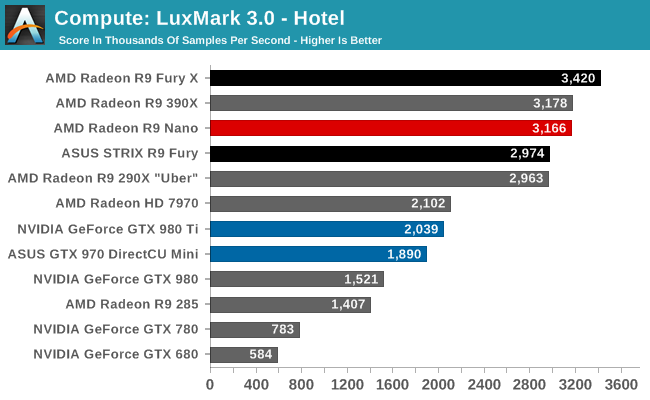
LuxMark ends up being a great corner case for where having a fully enabled Fiji GPU is more important than having the highest clockspeeds. With the R9 Nano able to flirt with its full 1000MHz clockspeed here, the card is able to pass the R9 Fury here. The only thing stopping it from taking the second-place spot is the R9 390X, as Hawaii still sees strong performance here even with fewer SPs.
For our second set of compute benchmarks we have CompuBench 1.5, the successor to CLBenchmark. CompuBench offers a wide array of different practical compute workloads, and we’ve decided to focus on face detection, optical flow modeling, and particle simulations.
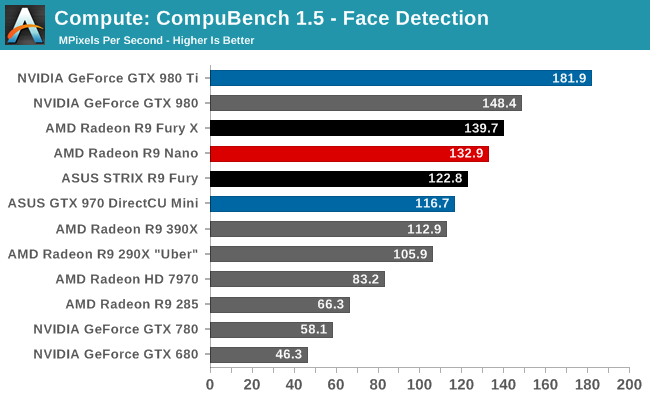
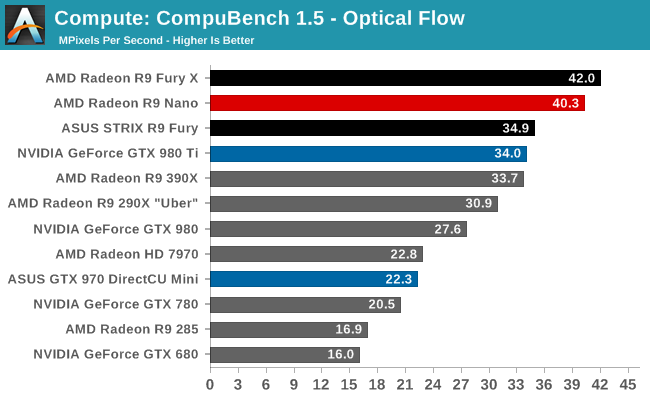
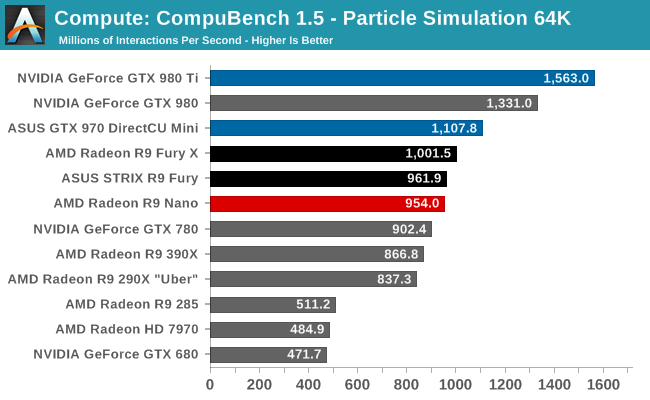
CompuBench provides us another case of where the R9 Nano ends up outpacing the R9 Fury. As a result AMD’s latest card tends to perform somewhere between an R9 Fury and R9 Fury X, with all of the strengths and weaknesses that come from that. This puts the R9 Nano in a good place for Optical Flow, while it will still trail NVIDIA”s best cards under Face Detection and the 64K particle simulation.
Meanwhile it’s interesting to note that AMD’s particle sim scores have significantly improved in the recent drivers. GCN 1.2 cards have seen 20%+ performance improvements here, which may point to some new OpenCL compiler optimizations from AMD.
Our 3rd compute benchmark is Sony Vegas Pro 13, an OpenGL and OpenCL video editing and authoring package. Vegas can use GPUs in a few different ways, the primary uses being to accelerate the video effects and compositing process itself, and in the video encoding step. With video encoding being increasingly offloaded to dedicated DSPs these days we’re focusing on the editing and compositing process, rendering to a low CPU overhead format (XDCAM EX). This specific test comes from Sony, and measures how long it takes to render a video.
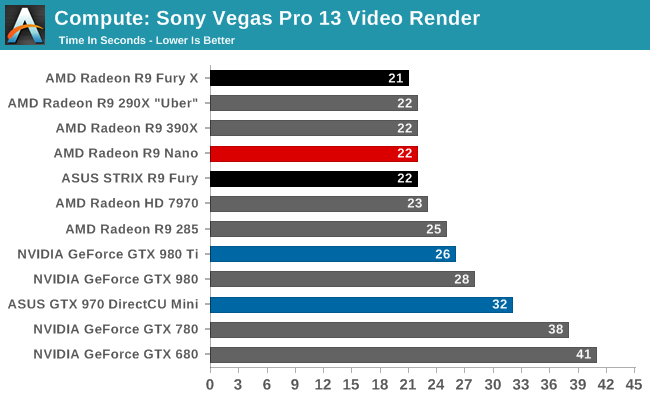
With Vegas there are no surprises; the R9 Nano ties the R9 Fury.
Moving on, our 4th compute benchmark is FAHBench, the official Folding @ Home benchmark. Folding @ Home is the popular Stanford-backed research and distributed computing initiative that has work distributed to millions of volunteer computers over the internet, each of which is responsible for a tiny slice of a protein folding simulation. FAHBench can test both single precision and double precision floating point performance, with single precision being the most useful metric for most consumer cards due to their low double precision performance. Each precision has two modes, explicit and implicit, the difference being whether water atoms are included in the simulation, which adds quite a bit of work and overhead. This is another OpenCL test, utilizing the OpenCL path for FAHCore 17.

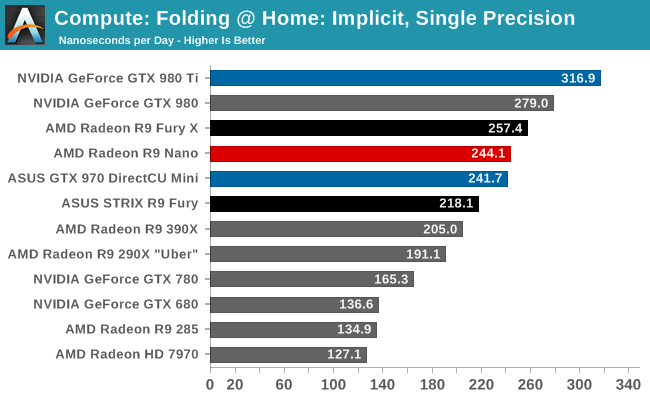
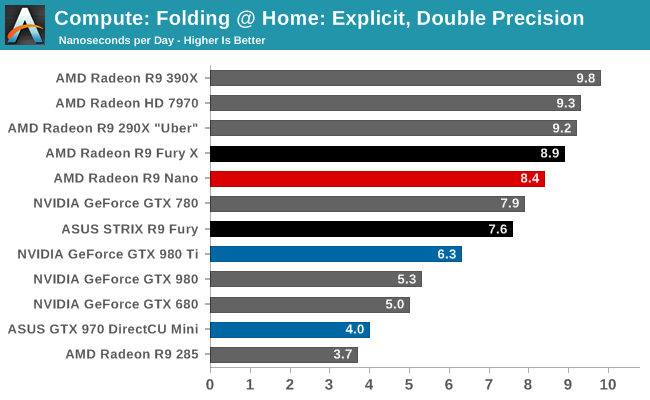
Much like CompuBench and LuxMark, the R9 Nano punches above its weight here. The lack of a graphics workload – and resulting demands on graphics hardware like the ROPs – means most of the card’s power can be allocated to the shaders, allowing higher clockspeeds. This gives the Nano a boost in this situation to bring it much closer to the Fury X, though as far as Folding goes AMD will still trail NVIDIA’s best cards.
Wrapping things up, our final compute benchmark is an in-house project developed by our very own Dr. Ian Cutress. SystemCompute is our first C++ AMP benchmark, utilizing Microsoft’s simple C++ extensions to allow the easy use of GPU computing in C++ programs. SystemCompute in turn is a collection of benchmarks for several different fundamental compute algorithms, with the final score represented in points. DirectCompute is the compute backend for C++ AMP on Windows, so this forms our other DirectCompute test.

Our final test sees the R9 Nano brought back to its place behind the R9 Fury, as the C++ AMP sub-tests are strenuous enough to cause more significant clockspeed throttling. Even behind the R9 Fury the R9 Nano does well for itself here, coming in behind the GTX 980 Ti and head of the R9 390X and GTX 980.










284 Comments
View All Comments
Oxford Guy - Tuesday, September 15, 2015 - link
I'll leave you to ponder this.Gunbuster - Thursday, September 10, 2015 - link
What a great little card for a miniature $3000+ boutique HTPC. Oh wait, no HDMI 2.0 for 4K.Asomething - Thursday, September 10, 2015 - link
you know you can add a passive dp-hdmi adapter right? its hard to find one that supports dp 1.2 but they exist. if $3000 plus an extra $30 is too much maybe dont make a $3000 HTPC.Gunbuster - Thursday, September 10, 2015 - link
Did you mean the fabled DP to HDMI 2.0 active converter that AMD keeps saying the channel will have "soon"Also once soon arrives we will have to see how well it actual works and if it introduces any input lag.
Fallen Kell - Thursday, September 10, 2015 - link
No, you can't buy a passive dp-hdmi adapter that supports proper HDMI 2.0+HDCP 2.2 that is needed for proper video content playback. These devices still do not exist. Parade Technologies has made an announcement on a chip/device to do this job, but they do not make end-user/consumer goods (think AMD/Nvidia when they do not make a reference card) and simply sell the chips to a vendor that makes the devices. They announced the product August 10th, 2015. It will be a good 4-6 months still before we see a vendor decide to make a product that uses that chip.ThomasS31 - Thursday, September 10, 2015 - link
So GTX980 Performance for GTX980Ti price... well.Some will probably interested in it... but this is "mispositioned" atm.
rhysiam - Thursday, September 10, 2015 - link
Kind of missing the point there I think. It's also slower and more expensive than a Fury (nonX), so if you don't want/need a small card then of course the Nano makes no sense whatsoever.The whole point of this card is it's size and (relative for AMD) efficiency, but naturally you need to either pay a little more or accept lower performance at the same price-point... that's the tradeoff.
TheinsanegamerN - Thursday, September 10, 2015 - link
but, if efficiency and size is a major selling point, why choose this over the 970 mini, which is half the price and uses less power?This makes the nano's market people who want a small mini itx card (so a HTPC case, as most itx gaming cases can take full size cards), which is efficient, but can't fathom buying an nvidia card, despite using less power while still performing well, and are willing to fork over 980ti levels of cash for 980 performance, to drive a 4k or 1440p displayport monitor (as there is no hdmi 2.0 on nano, so 4k tvs are out, and 1080p would favor the 970).
That's, like, a niche of a niche of a niche of a niche. Not really a major money making market for AMD.
przemo_li - Thursday, September 10, 2015 - link
But less performance too.I do not get why people get distracted with "energy efficiency" at all.
Its KING OF THE JUNGLE gpu. It's all about performance.
TheinsanegamerN - Thursday, September 10, 2015 - link
When you are building a small HTPC, which is the market AMD is aiming for with the nano, efficiency is very important. All that heat has to go SOMEWHERE. a lower consumption part won't produce as much heat. If you want a KING OF THE JUNGLE gpu, why are you looking at nano, and not titan x or fury x?